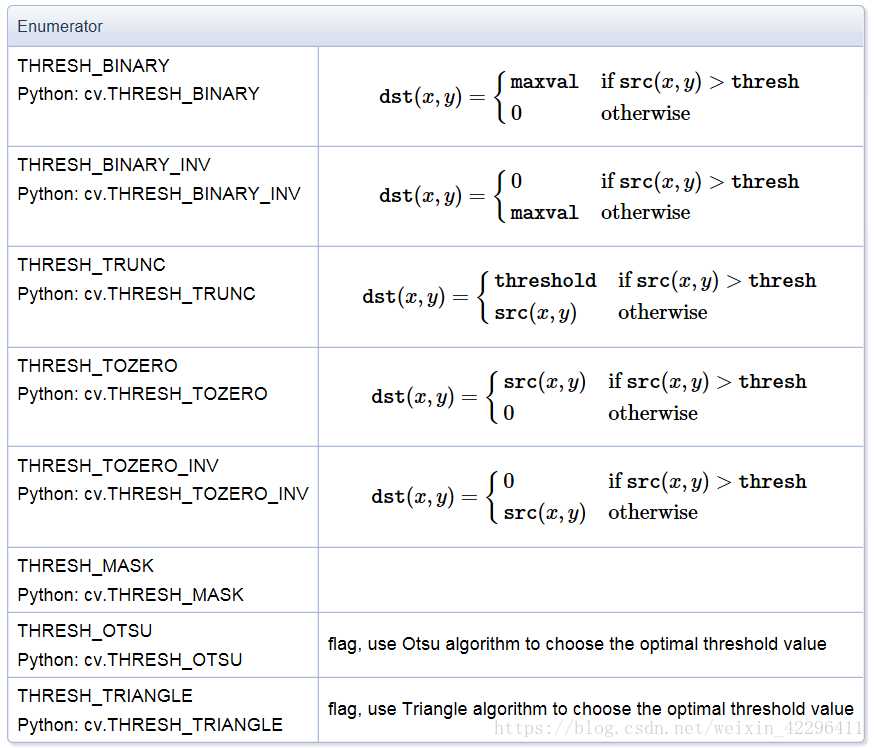标签:技术 最大值 height 截断 需要 hold 二值图像 import class
阈值处理是指将图像内高于一定值或者低于一定值的像素点进行处理
函数形式为:
retval ,dst = cv2.thresshold( src , thresh , maxval , type )
retval代表返回的阈值
dst代表阈值分割结果图像,与原始图像有相同的大小和类型
src代表要进行分割的图像,可以是多通道的
thresh代表要设定的阈值
maxval代表当type为THRESH_BINARY或者THRESH_BINARY_INV类型时,需要设定的最大值
type代表阈值分割的类型
具体类型如下

二值化阈值处理(cv2.THRESH_BINARY)
处理之后图像为只有两个值的二值图像
对于8位灰度图像,将超过阈值thresh的值处理为最大值255,低于阈值的处理位0
1 import cv2 2 import numpy as np 3 img=np.random.randint(0,256,size=[4,5],dtype=np.uint8) 4 t,rst=cv2.threshold(img,127,255,cv2.THRESH_BINARY) 5 print("img=\n",img) 6 print("t=",t) 7 print("rst=\n",rst)
img= [[ 98 151 50 196 238] [ 45 64 225 227 204] [ 45 19 46 233 82] [122 103 64 182 218]] t= 127.0 rst= [[ 0 255 0 255 255] [ 0 0 255 255 255] [ 0 0 0 255 0] [ 0 0 0 255 255]]
反二值化阈值处理(cv2.THRESH_BINARY_INV)
处理后的图像也是只有两个值的二值图像,
将灰度值大于阈值thresh的像素点,将其值处理为0,低于的处理为255
1 import cv2 2 import numpy as np 3 img=np.random.randint(0,256,size=[4,5],dtype=np.uint8) 4 t,rst=cv2.threshold(img,127,255,cv2.THRESH_BINARY_INV) 5 print("img=\n",img) 6 print("t=",t) 7 print("rst=\n",rst)
img= [[161 182 120 192 159] [ 64 197 108 242 182] [237 203 8 206 67] [ 31 7 190 226 22]] t= 127.0 rst= [[ 0 0 255 0 0] [255 0 255 0 0] [ 0 0 255 0 255] [255 255 0 0 255]]
截断阈值化处理(cv2.THRESH_TRUNC)
对于像素值大于阈值thresh的值将其处理为阈值的值,小于阈值的值保持不变
import cv2 import numpy as np img=np.random.randint(0,256,size=[4,5],dtype=np.uint8) t,rst=cv2.threshold(img,127,255,cv2.THRESH_TRUNC) print("img=\n",img) print("t=",t) print("rst=\n",rst)
img= [[ 31 121 210 126 117] [ 17 144 78 31 193] [ 91 143 27 58 103] [203 216 151 176 30]] t= 127.0 rst= [[ 31 121 127 126 117] [ 17 127 78 31 127] [ 91 127 27 58 103] [127 127 127 127 30]]
超阈值零处理(cv2.THRESH_TOZERO_INV)
超阈值零处理会将图像中大于阈值的像素点的值处理为0,小于或等于该阈值的像素点的值保持不变
1 import cv2 2 import numpy as np 3 img=np.random.randint(0,256,size=[4,5],dtype=np.uint8) 4 t,rst=cv2.threshold(img,127,255,cv2.THRESH_TOZERO_INV) 5 print("img=\n",img) 6 print("t=",t) 7 print("rst=\n",rst)
img= [[209 180 150 127 21] [ 11 227 7 223 211] [218 84 90 32 61] [101 129 240 36 176]] t= 127.0 rst= [[ 0 0 0 127 21] [ 11 0 7 0 0] [ 0 84 90 32 61] [101 0 0 36 0]]
低阈值值零处理(cv2.THRESH_TOZERO)
低阈值处理会将图像中小于或等于阈值的像素点的值处理为0,大于阈值的像素点的值保持不变
1 import cv2 2 import numpy as np 3 img=np.random.randint(0,256,size=[4,5],dtype=np.uint8) 4 t,rst=cv2.threshold(img,127,255,cv2.THRESH_TOZERO) 5 print("img=\n",img) 6 print("t=",t) 7 print("rst=\n",rst)
img= [[249 40 83 55 210] [195 144 246 163 230] [ 41 124 16 209 5] [ 48 177 190 118 75]] t= 127.0 rst= [[249 0 0 0 210] [195 144 246 163 230] [ 0 0 0 209 0] [ 0 177 190 0 0]]
标签:技术 最大值 height 截断 需要 hold 二值图像 import class
原文地址:https://www.cnblogs.com/miaorn/p/12207214.html